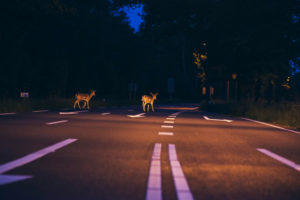11.22.2016
Deer Season Driver Safety Tips
 As you are probably aware, this time of year, all drivers (professional or those who merely commute to and from work) need to be aware of deer. Deer are most active at dusk and dawn, but can venture onto roadways at any time of the day. We are now in the peak season for deer/motor vehicle collisions; more than half occur in October and November as deer begin moving more during the breeding season. Collisions with deer and other large animals can cause significant damage to vehicles, and may cause injuries and even death to the driver and/or passengers. It is estimated that more than 149,000 vehicle/animal collisions occur in the US each year, resulting in more than 100 deaths.
As you are probably aware, this time of year, all drivers (professional or those who merely commute to and from work) need to be aware of deer. Deer are most active at dusk and dawn, but can venture onto roadways at any time of the day. We are now in the peak season for deer/motor vehicle collisions; more than half occur in October and November as deer begin moving more during the breeding season. Collisions with deer and other large animals can cause significant damage to vehicles, and may cause injuries and even death to the driver and/or passengers. It is estimated that more than 149,000 vehicle/animal collisions occur in the US each year, resulting in more than 100 deaths.
Here are some proactive driving tips to help prevent collisions:
- Deer collisions typically occur from sunset to midnight and in the hours just before and after sunrise, so be especially alert while driving during these times.
- Drive carefully through areas with high deer populations and deer crossing zones.
- If you see one deer crossing a road, watch out for more. Deer often travel in groups and move fast to stay caught up with the pack.
- Pay attention to changes in habitat along the road. The zone between habitat types is a likely place for deer to cross, such as creek bottoms and where agriculture fields meet woodlands.
- If you see brake lights ahead of you, it could be because the driver has spotted a deer. Stay alert as you drive through the area, as more deer could try to cross.
- Drive slower at night, giving yourself time to see deer with your headlights.
- Use your bright lights where permissible to locate animals as far ahead of your vehicle as possible. Many times a vehicle’s headlights will reflect off the eyes of animals, making them more visible.
- When a deer is sighted well ahead, sound your horn several times, flash your headlights (if there is no oncoming traffic) and reduce speed. If only a short distance away, the horn and flashing lights may spook the deer into running across the road, so slow down as safely as possible.
- Stay in your lane and brake firmly. Many deer-related accidents are actually caused by one car hitting another while attempting to avoid the animal.
- Always wear your seat belt.
- If you accidentally hit and kill a deer, report the location of the deer’s body to the city, county or state highway department that has jurisdiction over the road. Do not remove an injured or dead animal from a busy road. If you have damage to your vehicle, you will likely need to contact the police department in that jurisdiction so that an accident report can be filed.
Very often, hitting a deer is simply unavoidable, but keeping these tips in mind can help you be prepared should it occur. At Faith Technologies, we want all of our employees to arrive safely at their destinations every day, so please be especially mindful of the increased risk for car/deer accidents over the coming weeks.
If you enjoyed this blog article, please subscribe to stay up to date on the latest industry news from our experts at Faith Technologies.



